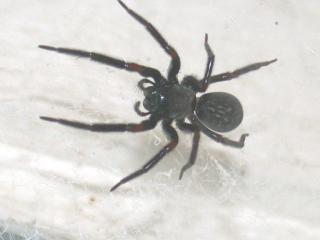Trapdoor spiders
Trapdoor spiders, Mygalomorphae, are also common throughout Australia. These are the old-world or primitive spiders (mygalomorphs) having downward-pointing parallel fangs instead of the more typical pincerlike fangs. This is why they rear up in an apparently aggressive manner when threatened. Trapdoors are not aggressive spiders and spend the majority of their normally retiring lives in their burrows.
Males will wander temporarily during mating season, and this is usually when these spiders are encountered. Males do not live long after reaching maturity, usually dying soon after, or during, mating.
Trapdoor spiders are similar in appearance to fellow mygalomorphs, the funnel-web spiders. Unlike funnel-web spiders, they are not considered life endangering, although the mouse spider, a type of trapdoor, is capable of a very nasty bite. Not all trapdoor species have a trapdoor lid covering their holes, although they all live in burrows. The females have long life spans ranging from 5–20 years, taking several years to reach maturity. Insects are their main prey, but prey will also include other spiders and other small animals.
Black house spiders
Black house spiders, Badumna insignis, are also called window spiders because of the tendency to build their webs around window frames. These untidy, zigzag threaded webs usually have one or two funnel-shaped entrances leading into a tubular retreat, and some people mistakenly think they may be funnel-web spiders. These robust, hairy spiders range from 9mm (male) to 18mm (female) in length, are grey to black in colour, and are found Australia wide.
Black house spiders are timid and bites to humans are rare but may be painful and can cause general symptoms such as nausea, sweating and vomiting. In a few cases necrotic skin lesions have been reported after multiple bites.
These spiders catch a lot of flying insects around the home and garden, but are generally not tolerated well because of their messy webs around windows, eaves and even the mirrors of the family car! Enemies of these spiders include parasitic wasps, birds and the white-tailed spider.

